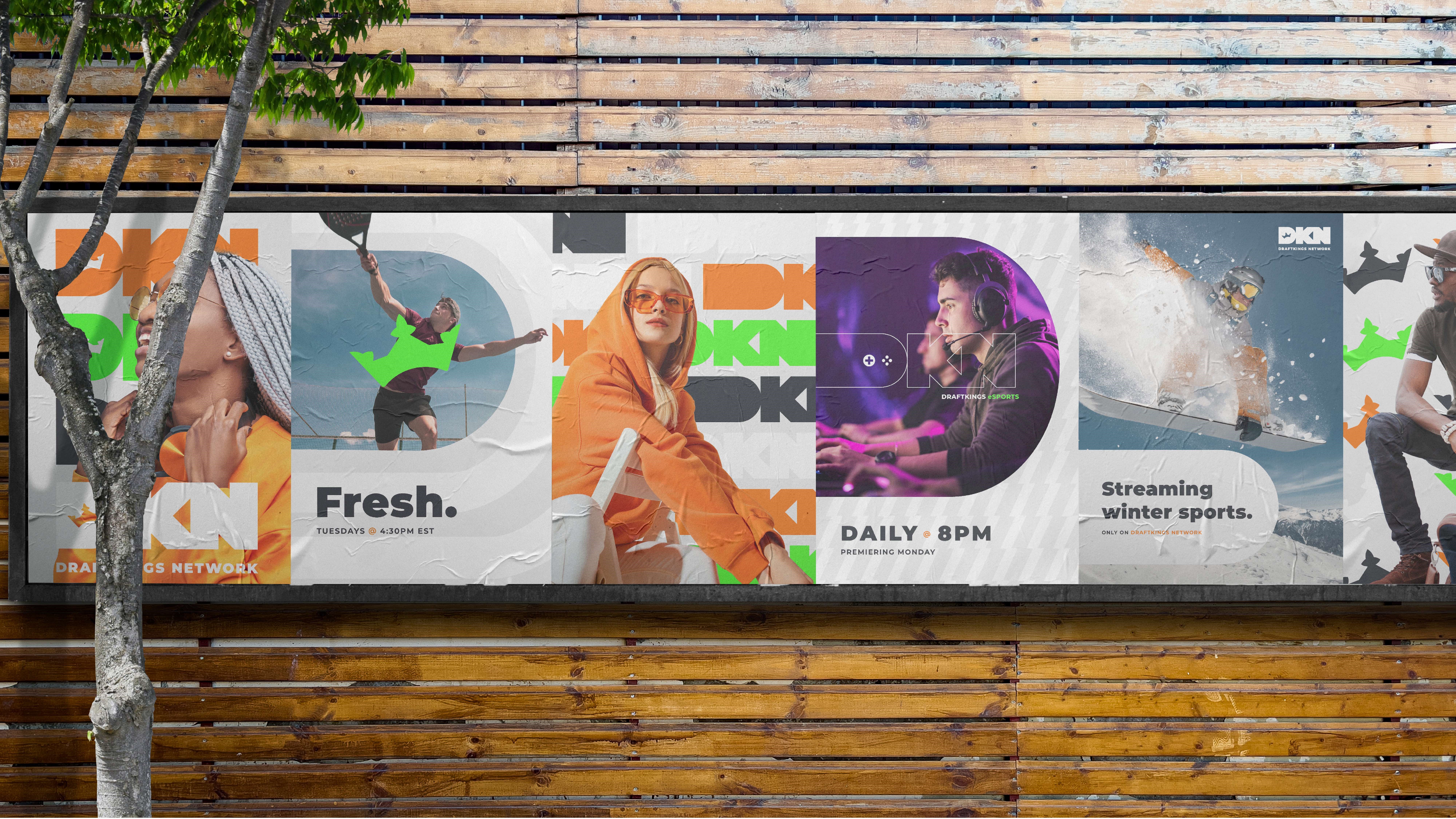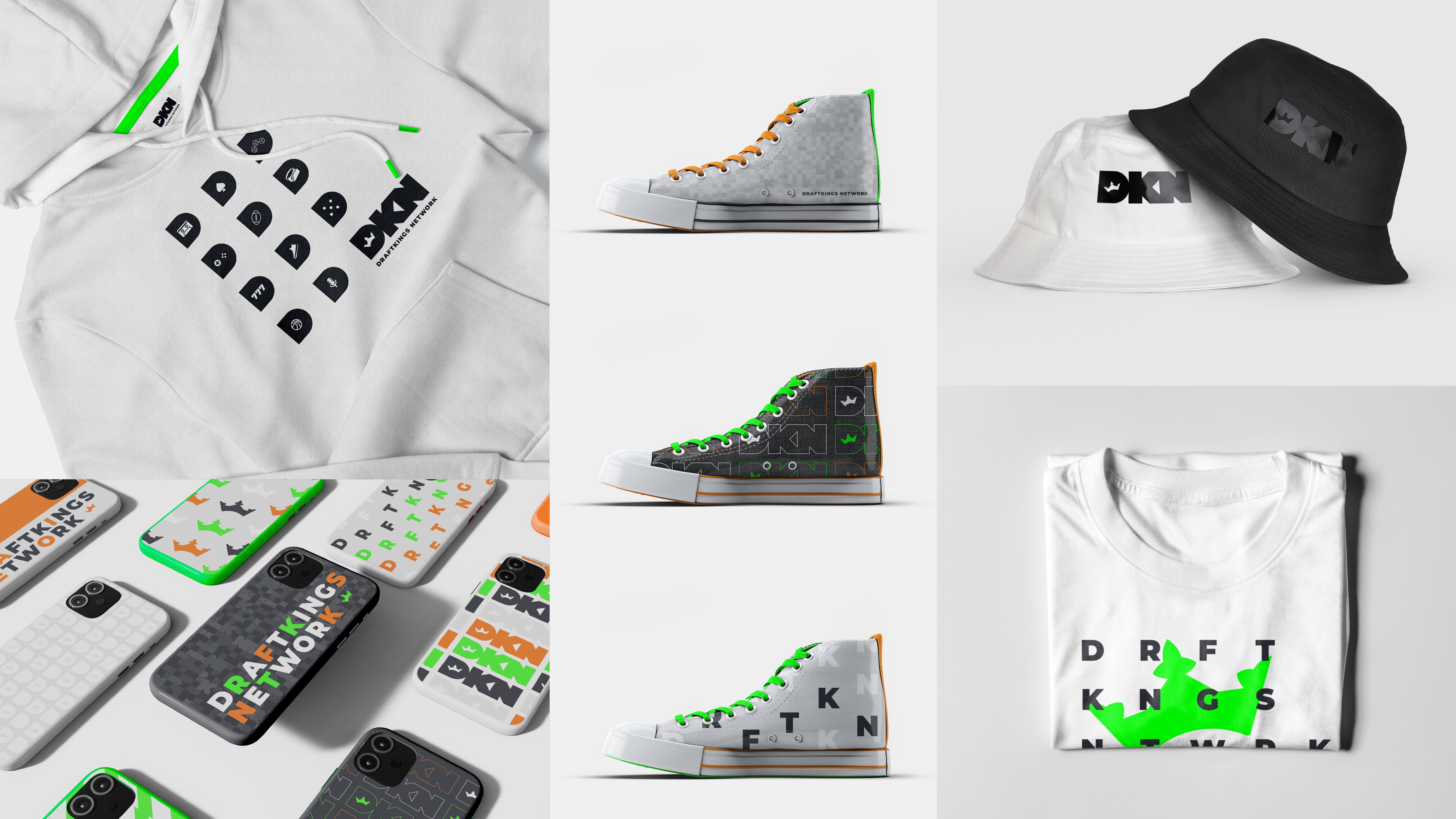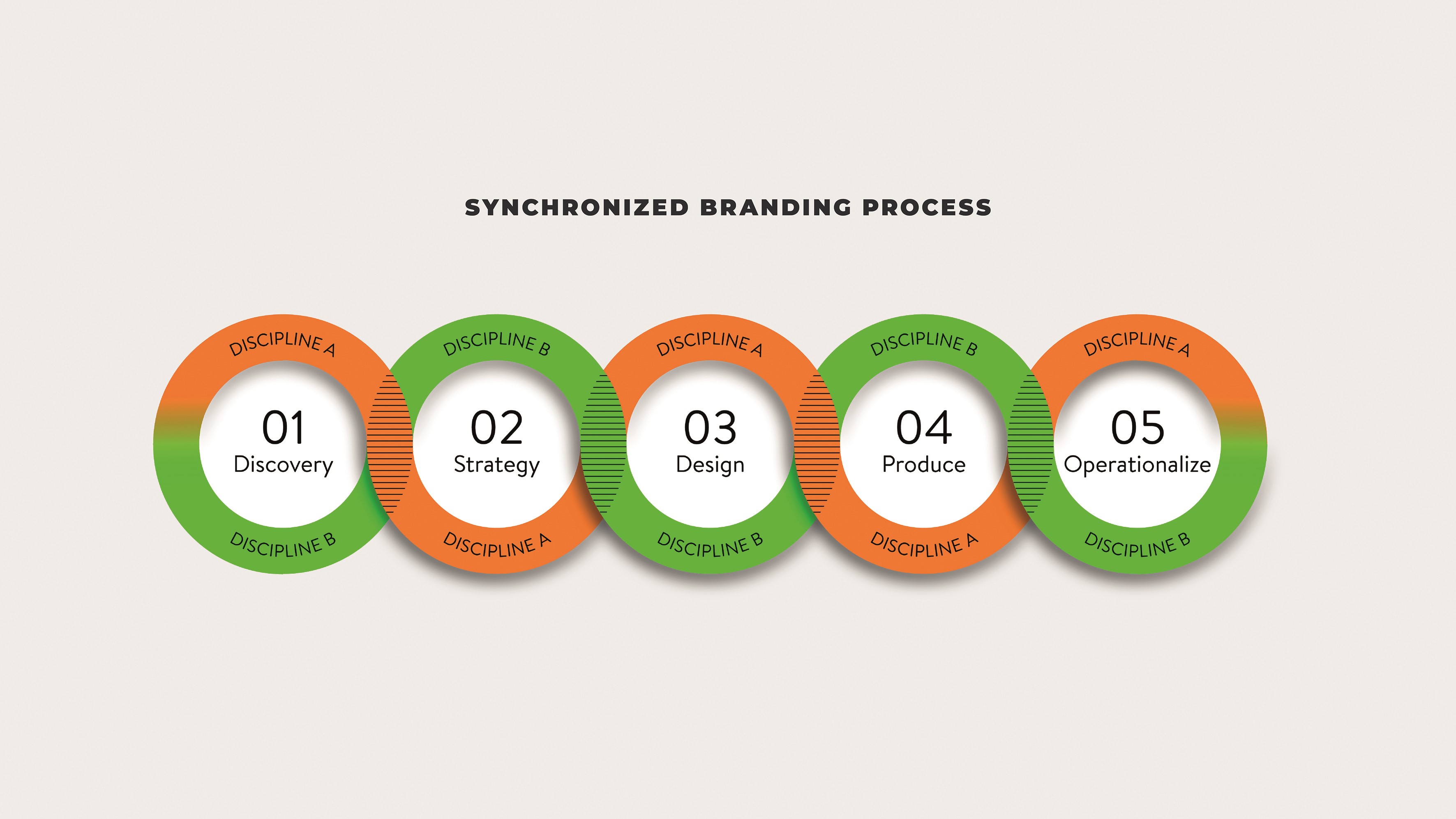Electric ensemble

Designers who created the new DraftKings Network identity believe they have discovered a new and better way of crafting brands. But what is this new process of intensive collaboration and creativity? Jack Cousins reports.
For a long time, the assumption has been that best practice in extensive branding projects involves a more linear approach, with each interest group working on the project keeping at an arm’s length from one another. The design agency will research and strategise before constructing a visual identity, which will then inform the work of other specialist companies that the particular project demands, such as sonic or digital. The client, meanwhile, will watch on from the sideline after providing the brief, and will only interact with the work once its presented back to them.
This is a generalisation, of course, yet it remains true to many brand design projects worldwide. But has a new and better way forward been discovered? In 2022, American fantasy sports contest and sports betting firm DraftKings recognised it needed a unifying media brand for its audio, video and digital content properties that live across multiple distribution endpoints. Despite the category growing, audiences struggled to differentiate competitors beyond limited time offers alone. The DraftKings business model of getting as close as possible to its target market of content hungry millennial males would be underpinned by the rollout of its 24/7 live stream channel. If all went to plan, the newly formed DraftKings Network would provide a unified editorial platform, featuring sports betting and daily fantasy tips as well as breaking news and analysis that would extend to adjacent passion areas.
By revising the infotainment network, DraftKings aimed to change the category forever. It turned to Makerhouse, a WPP-owned creative production house, and Sonic Lens, an audio branding agency, to develop a brand strategy which could future-proof the organisation’s ambitious endeavour. This was not going to be an easy project, however, and communication would be key. Quite how this could be achieved in a post-pandemic culture, with three strong-willed parties involved – all located hundreds of miles from one another – must not have appeared straightforward. But as the project was replete with talent, things started to click early on.
Coming together as one
On the design side, the Makerhouse team had vast brand design expertise, and had already previously worked with DraftKings. Marco Vitali was the founder of award-winning agency Sonic Lens, and DraftKings’ senior director, Scott Salsbury, had experience of being on both agency and client side. Placing faith in one another, it was decided from the get-go that everyone would contribute and be listened to, even from the research phase.
Christine Jones, global executive design and content director at Makerhouse, explains, “I think what was unique about this project was the way we worked and collaborated together. Within our research phase, what we had typically done as a standard visual and brand identity discovery was completely turned on its head by the sonic expertise that Marco brought to us and the knowledge of the industry that Scott brought to us.”
One of the most significant aspects of working in this new inclusive way was the joy it brought to everyone involved. After a period of respectively working on design and audio, Makerhouse and Sonic Lens would come together for feedback. Music would be played by Vitali while visuals would be exhibited by the Makerhouse team. By riffing off each other’s work, not only did the revised brand become more cohesive but it afforded the parties an education on brand disciplines to which they had limited prior knowledge. Now, many months on now from the project’s launch, Makerhouse group design director Anne Brinich still smiles when reminded of the dancing, excitement and strong sense of purpose in those meetings. “Those were by far the most fun I've ever been in,” she hastens to add.
The co-leading of client workshop sessions and sitting in on each other’s research and analysis meant the two creative agencies were able to effectively formulate a brand strategy. This process of influencing each other’s work, coined ‘synchronised branding’, resulted in the team uncovering electronic dance music (EDM) as a means of reflecting DraftKings Network’s core brand values of ‘fresh, curious, electric, knowing and exciting’. Specifically adopting trap music, a subgenre of EDM, hoped to maximise relevance amongst the target audience.
The defining brand pillar of DraftKings Network, which would overlap both audio and visual, was the ‘Drop’. Playing directly into the idea of integrating EDM into the brand, the ‘Drop’ became a device which could build suspense before delivering a satisfying payoff, just as DJs create at raves. Following a similar pattern to short stories, the ‘Drop’ has been used in some of the most recognisable sonic brands. HBO, THX and DreamWorks were all examples Vitali took inspiration from.





Twinning the ‘Drop’ with the brand value of electricity took the sonic identity onto another level. The team attended an industrial workshop where Tesla arcs and plasma lamps were used to create ‘virtual instruments’. Producing visceral noises, they mimicked a current running through the DraftKings Network sonic brand. Further excitement was added through collaborating with touring DJ producers to ensure the sound was as legitimate as possible and had no traces of corporatism whatsoever.
A flexible design
With DraftKings Network operating as an omnichannel for a wide and varied audience, the sonic identity had to cover all bases. Vitali explains, “The audio signature for DraftKings isn't just one thing, it's the idea of the ‘Drop’ which they now own. From sports to news to tech to the masterbrand, as long as you can feel that structure and recognise it, you'll get the brand attribution that you're looking for. That allowed us to create versions using the most signature elements that are recognisable, but we change the sounds. For the sports one, we use big brassy sounds, big hits and grunts, but still follow the formula. It gives you the ultimate range of flexibility.”
Another crucial difference between the DraftKings Network sonic identity and the renowned audio brands which inspired it is how the music interweaves with the visual elements. By pushing darker colours aside for bright neon greens, electricity pulses through the revised brand, adding to that strong sense of freshness. Meanwhile, the brand’s iconic tilted crown has been incorporated into a logo which features large, bold type. Translating the sonic energy and excitement into the visuals further adds to the swagger and a heightened sense of authority in the category.

Launched in March 2023, the DraftKings Network brand performed well in a focus group comprised of people representing its audience. Remarkably, the top five adjectives used to describe the updated brand fell in line with its core brand values (“fresh”, “exciting”, “inviting”, “electric” and “credible”). While important, it wasn’t just the quality of the results that mattered in the end. The satisfaction the client had from seeing the agencies working together with a genuine enthusiasm, and then actively involving them in the process with open arms, left DraftKings knowing little more could be done to create a stronger brand. For Salsbury, the project opened his eyes to how branding projects could be, and perhaps ought to be.
He says, “Being with Marco in every meeting was an incredible education, and just one of many reasons why I love this project. I don't have a tonne of experience on the sonics side, so a lot of this was new for me. I would absolutely say [‘synchronised branding’] is critical, this idea of having everybody at the table together and collaborating from day one. For me, I now have an entirely new perspective on brand identity creation and the value I place on the sonics side.”


So, impressive results and a happy client. If the team is right and a novel way of creating brands has been uncovered, then it may therefore seem a mystery why design agencies do not use this method all the time. From the outside, it might seem like common sense to elicit input from specialist agencies, like Sonic Lens, and those who know the brand better than anyone else, the client, yet this is seldom the case. “Where I sit on the sonic side, this kind of collaboration never happens,” confirms Vitali.
Jones believes this may be because egos can get in the way, which simply wasn’t a problem in this project. Apart from that, coordinating virtual and, crucially, physical meetings can be strenuous, especially when working from different states. “If we hadn't been together and jumping out of our seats with excitement when Marco introduced the ‘Drop’, I don't know that we would have achieved this result,” she muses.
Throughout the project, the team was able to identify over time an unofficial set of guidelines for how ‘synchronised branding’ works. It will fail if the design agency finds the client is happy to sit back and solely comment on work presented to it, rather than being an active part of the brand’s evolution. It will also fail if its agency partners prefer to have the strategic direction dictated to them, offering up none of its expertise. If true ‘synchronised branding’ cannot be achieved, ultimately it is the cohesiveness of the brand that will pay. But if everything falls into place, it is possible brand design can reach new heights. At any rate, DraftKings, Makerhouse and Sonic Lens certainly all now believe so.
This article was taken from Transform magazine Q3, 2023. You can subscribe to the print edition here.












